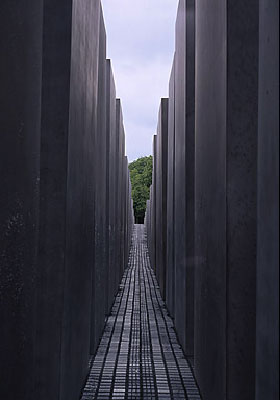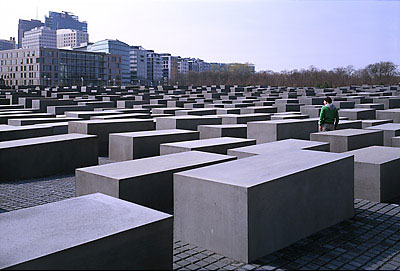reprinted with my permission, from Artforum, January, 2006
WAGING WAR ON FORGETTING is the task of all memorials, which are places where different kinds of memory and concepts of representation collide. In contemporary Berlin, the politics of memory are particularly vexed. Since the end of the cold war Berlin has tried, with varying degrees of success, to knit its divided halves together and reconnect with its past—or parts of it. Out of the rubble of war and discarded ideologies, the German capital has reestablished the old city center around the stately Unter den Linden, displacing the hubs of East and West Berlin from Alexanderplatz and Kurfürstendamm, respectively. Political, economic, and cultural considerations have dictated various strategies of reconstruction. Norman Foster's glass dome, a somewhat strained metaphor for transparency, now crowns the Reichstag; commercial areas such as Friedrichstrasse, Potsdamer Platz, and, to a lesser extent, Pariser Platz have been rebuilt with modern structures along the old street pattern; and funds are being raised to erect simulacra of landmarks such as Karl Friedrich Schinkel's Bauakademie (Academy of Architecture) and Andreas Schlüter's Stadtschloss (City Palace), both demolished after the war.
Peter Eisenman's Denkmal für die ermordeten Juden Europas (Memorial to the Murdered Jews of Europe), inaugurated on May 10, 2005, disrupts the seamlessness of this historicizing project and the intellectual fretwork that subtends it, a point made clear by the two names by which the project is known—the official designation, Denkmal (memorial), and the title commonly used by the public, Mahnmal (warning). The five-acre field of stark concrete stelae stands at the very heart of the emblematic area adjacent to the Brandenburg Gate, a short distance from the Reichstag, and flanking on one side the former course of the Berlin Wall. The 2,711 stelae, all with the same footprint and arrayed in parallel rows, are designed to counter the geometric uniformity of the grid. They are set at different angles, some leaning slightly to one side or another, their size increasing gradually and irregularly toward the middle of the site while the ground undulates unpredictably. At the edges of the field, the fabric of the pattern begins to fray, until it meshes with the surrounding streets.
Picking his way carefully among countless practical and theoretical obstacles, Eisenman has tried to redefine the role of the memorial in the modern city and of architectural language as a medium capable of evoking, rather than representing, an event incommensurate with individual experience. (Richard Serra, who coauthored the first version of the project, withdrew in 1998 when Helmut Kohl, then chancellor of Germany, asked for changes in the design.) From the beginning, and thus programmatically, the architect sought a powerful contrast to the deadening mediocrity of contemporary architecture in Berlin, which, with few exceptions, has failed spectacularly to make meaningful contributions to the cityscape. Rejecting outright the allure of the monumental, Eisenman offers a critique, equally trenchant but sympathetic in this case, of the city's other architectural sites of remembrance. The fact that some of Berlin's most moving tributes to victims of the Holocaust refer to specific historic moments has encouraged figurative solutions: empty bookshelves at Bebelplatz, for example, or a table and fallen chair at Koppenplatz. This preoccupation with mimesis, which is, or can be, proper to sculpture, has spread to architecture (not only in Berlin), and it is against this trend that Eisenman's memorial takes a forceful stand.
The attempt to make architecture speak through figurative means is hardly new. Architecture parlante, a term coined in the nineteenth century, has made a comeback both in popular architecture and in the work of avant-garde practitioners like Frank Gehry, whose large-scale icons sometimes recall the work of Claes Oldenburg. In Berlin, this genre makes its most significant appearance in Daniel Libeskind's Jewish Museum, where certain spaces—the Garden of Exile, for example—were designed to prompt emotional or physical feelings of anxiety or discomfort in the viewer. Eisenman rejects the literal speech of architecture parlante, which leaves the viewer little freedom: Form and referent coincide, and response rarely goes beyond the initial frisson. In memorializing events of this magnitude, it is not the immediate, visceral reaction but the critical reception, the work's potential to generate independent thinking, that matters.
For Eisenman, the Shoah is not just a historical occurrence but also an epistemological shift: "After the Holocaust, one cannot use [architectural] language to articulate it," he claims, in reference to Adorno's famous statement that writing poetry after Auschwitz is "barbaric." And yet Eisenman does build, and while the Mahnmal refuses to "represent" the Holocaust, it implies the possibility of a shared language—critical, to be sure, intransigent in its polemical stance, but capable of communication nevertheless. In defining the kind of language that is appropriate after the Holocaust, Eisenman was faced with Kafka's painful dilemma, subsequently stressed by Hannah Arendt: the impossibility of not writing, the impossibility of writing in German, and the impossibility of writing differently. For Eisenman, not building was clearly not an option, nor was building according to conventional vocabularies of memorialization. It was also impossible to build entirely outside tradition, because any architecture presupposes some reference to socially sanctioned codes of use. Steering an even course between the symbolic and the abstract, Eisenman's stelae evoke an archaic Ur-language, found in ancient civilizations of both East and West, that conveys the idea of death while muting the expression of affect. By going back to timeless archetypes, he bypasses the slag heap of historicism and yokes the memorial to a heavy sense of time, far from the everyday and the customary. The endless grid calls up not only the scale and methodical nature of state-sponsored genocide but the immensity of the Dead. It does so, however, without falling prey to the transcendental consolations of the sublime that serve to empower the viewer at the expense of introspection. The project is resolutely opaque: Its strength lies precisely in the numbing silence of the rows of stelae, which do not arouse empathy but foreclose it. It is this insubmissive muteness that Jürgen Habermas described, in an article on the memorial published in Die Zeit, as "the unobtrusive pathos of the negative." No words or inscriptions give voice to grief, which is left to the private realm of individual response.
Beneath the site's southeast corner an underground information center, its entrances carefully woven into the fabric of the memorial, documents different aspects of the Shoah. Eisenman has set up the two parts of the Mahnmal, the memorial proper and the information center, in dialectical relation to one another. In his own Die Zeit essay on the Mahnmal, philosopher Giorgio Agamben eloquently distinguishes between the two kinds of memory embodied here: the information center, which transmits archival and historic material through words (the memorable), and the silence of the thicket of pillars above, which denies closure (the unforgettable).
Some have voiced the fear that, in this work, identification with the victims takes the focus off the perpetrators. Yet things are not quite so clear-cut. Irreducible to any single meaning, Eisenman's lieu de mémoire nonetheless speaks to the German, Jewish, and German-Jewish contexts in a language that is neither familiar nor entirely foreign. The burden of signification falls squarely on the spectator. Passing associations—from old Jewish cemeteries and their uncertain tombstones to the quarries exploited by the Nazis using slave labor—inevitably arise when viewing the memorial. But the project's evocative power also brings back fleeting memories of the country's own architectural past: The ascending stelae call to mind Bruno Taut's unbuilt Stadtkrone (City Crown) of 1919. Taking his cues from old medieval towns clustered tightly around their cathedrals and from the pyramidal design of temples and stupas, Taut proposed a set of modern, geometric prisms crowned by a towering centerpiece. Mies van der Rohe abstracted and secularized the model even further in the Weissenhof housing estate built by the Werkbund in 1927. Eisenman's memorial differs radically from these projects in scale, plan, and elevation. Yet modernity's utopian dreams reverberate darkly and distantly in this work of such different ideological charge, an echo from the past that rebounds with biting irony: There is no transcendental crux here, no eye-catcher to anchor the composition.
As with many contemporary thinkers, Eisenman rejects the redemptive notion of collective memory and its unexamined links to the sacred, which unite its celebrants in a reassuring cult of remembrance. Memorials, Eisenman has noted, are not about memory but about nostalgia. In this case, architecture becomes a hermeneutic, probing, questioning, withholding solace and thus closure. However challenged or troubled by the work, visitors are never overwhelmed nor reduced to anxious impotence. Nothing affects them without their active, willed participation. By avoiding an iconic design, Eisenman has ensured that the whole cannot be apprehended from any single vantage point. There is no center, no resting spot for the eye or the body, no therapeutic catharsis. The tight weave of the project never loosens its grip on visitors, or allows them to yield attention to apperception. They have to negotiate the narrow fissures between the somber stelae virtually in single file. Anamnesis becomes a personal rather than a collective endeavor, and the injunction to remember is left the responsibility of each individual spectator.
Eisenman did not want to aestheticize his response to genocide: The chasm opened up by the Holocaust cannot be designed away. Paul Celan, whose poetry proved Adorno wrong, described his own choice of idiom in words that could well apply to the Mahnmal: "[I]t is a ‘greyer' language, a language which wants to locate even its ‘musicality' in such a way that it has nothing in common with the ‘euphony' which more or less blithely continued to sound alongside the greatest horrors." Eisenman's harsh forms stand without appeal, defiantly resisting the primacy of the optical. Too often, the viewer's attention is arrested by the spectacle of the signifier, an iconocentric image that short-circuits the referent. Here, although the austere minimalist stelae foreclose any possibility of sublimation, the changing light of day, the pedestrian's shifting point of view, and the clash between the lithic gray mass of the memorial and the foliage of the Tiergarten across the street can be unexpectedly striking: Light bounces off the bleak, sharp-edged prisms, showing up an Escher-like play of gray on gray. But we are constantly brought back to the crushing weight of the waves of stone that surge and swell and seem to burrow beneath the city, undermining the smugness of the modern capital and interrupting its continuities. It is here, ironically, in this bitter field dwarfed by surrounding buildings, that modern Berlin has found a fitting Stadtkrone.
Esther da Costa Meyer teaches architectural history in the Department of Art and Archaeology at Princeton University.

